Auditory Uta-Karuta: Development and Evaluation of an Accessible Card Game System Using Audible Cards for the Visually Impaired
Abstract
1. Introduction
2. Related Works
3. Auditory Card Game System
3.1. Karuta
- Phase 1:
- Recognition Torifuda layoutArrange the Torifuda face up on a flat surface in front of the players. Players memorize the contents and position of the Torifuda as much as possible.
- Phase 2:
- Read out of YomifudaThe game master randomly draws a Yomifuda from the deck and starts reading it out.
- Phase 3:
- Race of finding TorifudaPlayers race to determine which Torifuda corresponds to the Yomifuda and touch/grab/claim what they think is the correct Torifuda.
3.2. Auralization
3.3. Auditory Uta-Karuta
- Phase 0:
- Assignment of Torifuda devicesThe first step is to establish wireless communication between the Torifuda devices and the Yomifuda device. The wireless communication was implemented using Apple’s “MultiPeer Connectivity” framework, and all communication was done in signal to avoid delays as much as possible. After communication is established, the Yomifuda device randomly assigns content from its own sound data set for each of the Torifuda devices. At the same time, Yomifuda device gives the numbers to the Torifuda devices. This number indicates the order in which the Torifuda devices are presented with the sounds in Phase 1.The Torifuda devices hold the sound data used in the experiment. When given signal indicating a particular sound from the Yomifuda device, the Torifuda devices find the appropriate sound in its own sound data and prepares to play it. Similarly, when given signal indicating the order of read out, the Torifuda devices set the waiting time until playback according to the value of the signal.
- Phase 1:
- Recognition of Torifuda LayoutArrange the Torifuda devices face up on a flat surface in front of the players. When the game master presses the “Start” button displayed on the Yomifuda device, a signal the start of read out is given to all connected Torifuda devices. When the Torifuda devices receive a signal the start of read out from the Yomifuda device, they start reading based on the pre-set wait time and sound data. Players memorize the contents and position of the Torifuda devices as much as possible.
- Phase 2:
- Read out of YomifudaThe screen of the Yomifuda device shows the same number of buttons as the number of sounds used in the experiment. Each button corresponds to a sound, and when a button is pressed, the corresponding sound is played from the Yomifuda device. The game master operates the Yomifuda device, selects the Yomifuda, and presents the corresponding audio signal through the Yomifuda device.
- Phase 3:
- Race of Finding TorifudaPlayers race to determine which Torifuda devices corresponds to the Yomifuda, and touch/grab what they think are the correct Torifuda devices. In this phase, only the touched Torifuda device gives its own card order to the Yomifuda device. The Yomifuda device determines whether or not the correct Torifuda device was touched based on the card order given, and plays the correct/incorrect sound effect.
- Type :
- In Phase 2, all Torifuda devices do not present the sound.
- Type :
- In Phase 2, all Torifuda devices present the sound.
4. System Evaluation
4.1. Overview
4.2. Stimuli and Equipment
4.3. Procedure and Evaluation
- Case 1:
- Person with a visual impairment vs. sighted person
- Case 2:
- Person with a visual impairment vs. sighted person with a blindfold
- Case 3:
- Sighted person vs. sighted person with a blindfold
- (a)
- Winning Rate:Winning rate of the people with visual impairments in Cases 1 and 2 and of those with a blindfold in Case 3.
- (b)
- Subjective Evaluation of the Opponent:The opponent’s strength [0, 100] when the player strength is 50.
4.4. Results and Discussion
5. Suggestion for Suitable Auditory Cues in Auditory Card Game System
5.1. Overview
5.2. Valuable Parameters
- (1)
- Degree of visual impairment: Since the proposed system assumes that people with visual impairments can participate in the same board game together with sighted people, we prepared sighted people and people with visual impairments as parameters indicating the degree of visual impairment. Furthermore, in order to clarify how much the visual information contributes to grasping the contents and position of the components for the sighted, the sighted people with a blindfold were prepared.
- (2)
- Audio types: As shown in Table 2, the presentation of information using auditory stimuli can be divided into verbal sounds and nonverbal sounds, the latter of which can be further divided into representational sounds and abstract sounds. A typical of representational sounds is “auditory icons” [38], and a typical of abstract sounds is “earcons” [39]. Representational sounds are real world sounds that have a direct association with an object, and abstract sounds are synthetic sounds that have no direct association with an object. Each of these types of sound have advantages and disadvantages. The advantage of verbal sounds is the meaning of the message is relatively unambiguous [38]. However, users have to listen to the whole message to understand the meaning. Moreover, verbal sounds have language limitations. The advantage of representational sounds is that they can convey complex messages in a single sound. In addition, representational sounds are easy to identify by analogy. However, they cannot be assigned real world sounds for all events. The advantage of abstract sounds is flexibility. They can present information in a systematic way [38]. Further, they can represent hierarchies by controlling their parameters such as timbre and pitch. However, they have difficulties associated with learning and remembering. In this experiment, we prepared three types of audio to be used: A: verbal sounds, B: representational sounds, and C: abstract sounds.
- (3)
- The style of sound playback: We prepared two types of sound playback. Type , presents the auditory stimuli one by one in order, and Type presents the sound for all audible cards at the same time. While Type has the advantage that players can clearly recognize the information of the audible card one by one, Type has the advantage that players can obtain the information of multiple audible cards at once.
5.3. Stimuli and Equipment
5.4. Results
5.5. General Discussion
- 1.
- Sound identification error: experimental participants misinterpreted the meaning of the audible card presented them.
- 2.
- Vertical localization error: experimental participants misplaced the audible card presented them in the vertical direction.
- 3.
- Horizontal localization error: experimental participants misplaced the audible card presented them in the horizontal direction.
5.6. Expandability
6. Conclusions
- 1.
- Abstract sounds can adversely affect sound localization abilities and should not be used where component location sharing is required.
- 2.
- In order for all players to correctly recognize the position of the components, audible cards should be aligned horizontally.
- 3.
- It is preferable that the sounds stimuli used in the audible card be composed of representational sounds as much as possible.
- 4.
- When using abstract sounds, it is recommended to limit the number of auditory stimuli from about 5 to 8 in order to reduce recognition error.
- 5.
- It is effective to sound the audible cards one by one so that players can accurately recognize the location and information of multiple audible cards.
- 6.
- When presenting multiple audible cards at the same time, it should be limited to about three cards, and no verbal sound should be used in this case.
Author Contributions
Funding
Institutional Review Board Statement
Informed Consent Statement
Conflicts of Interest
References
- da Rocha Tomé Filho, F.; Mirza-Babaei, P.; Kapralos, B.; Moreira Mendonça Junior, G. Let’s Play Together: Adaptation Guidelines of Board Games for Players with Visual Impairment. In Proceedings of the 2019 CHI Conference on Human Factors in Computing Systems, Glasgow, UK, 4–9 May 2019; p. 631. [Google Scholar]
- Zan, B. Interpersonal Understanding Among Friends: A Case-Study of Two Young Boys Playing Checkers. J. Res. Child. Educ. 1996, 10, 114–122. [Google Scholar] [CrossRef]
- Konieczny, P. Book Review: Stewart Woods, Eurogames: The Design, Culture and Play of Modern European Board Games. Int. Sociol. 2017, 32, 671–673. [Google Scholar] [CrossRef]
- Potter, R.J. Encounters: Two Studies in the Sociology of Interaction. Erving Goffman. Am. J. Sociol. 1962, 68, 125–126. [Google Scholar] [CrossRef]
- Yuan, B. Towards Generalized Accessibility of Video Games for the Visually Impaired. Ph.D. Thesis, University of Nevada, Reno, NV, USA, 2009. [Google Scholar]
- Andrade, R.; Rogerson, M.J.; Waycott, J.; Baker, S.; Vetere, F. Playing Blind: Revealing the World of Gamers with Visual Impairment. In Proceedings of the 2019 CHI Conference on Human Factors in Computing Systems, Glasgow, UK, 4–9 May 2019; p. 116. [Google Scholar]
- Maia, J.; Del Prette, Z.; Freitas, L. Social skills of visually disabled people. Rev. Bras. Ter. Cogn. 2008, 4. [Google Scholar] [CrossRef][Green Version]
- Werner, E.E.; Smith, R.S. Journeys from Childhood to Midlife: Risk, Resilience, and Recovery; Cornell University Press: Ithaca, NY, USA, 2001. [Google Scholar]
- Jessup, G.M.; Cornell, E.; Bundy, A.C. The treasure in leisure activities: Fostering resilience in young people who are blind. J. Vis. Impair. Blind. 2010, 104, 419–430. [Google Scholar] [CrossRef]
- Hamada, T. The Arabian Pots. Available online: https://boardgamegeek.com/boardgame/179956/arabian-pots (accessed on 17 March 2021).
- Stippell, C. Nyctophobia. Available online: https://boardgamegeek.com/boardgame/249505/nyctophobia (accessed on 17 March 2021).
- Robbins, M. Uno. Available online: https://boardgamegeek.com/boardgame/2223/uno (accessed on 17 March 2021).
- Bauza, A. Hanabi. Available online: https://boardgamegeek.com/boardgame/98778/hanabi (accessed on 17 March 2021).
- Miyakawa, H.; Kuratomo, N.; Salih, H.E.B.; Zempo, K. Auditory Uta-KARUTA: Sonificated Card Game Towards Inclusive Design. In The Adjunct Publication of the 32Nd Annual ACM Symposium on User Interface Software and Technology; ACM: New York, NY, USA, 2019; pp. 90–92. [Google Scholar] [CrossRef]
- AudioGames.net. Available online: https://audiogames.net/ (accessed on 17 March 2021).
- Westin, T. Game accessibility case study: Terraformers—A real-time 3D graphic game. In Proceedings of the 5th International Conference on Disability, Virtual Reality and Associated Technologies, Oxford, UK, 20–22 September 2004. [Google Scholar]
- Sánchez, J.; Baloian, N.; Hassler, T.; Hoppe, H. AudioBattleship: Blind learners collaboration through sound. In Proceedings of the CHI’03 Extended Abstracts on Human Factors in Computing Systems, Austin, TX, USA, 30 April–4 June 2003; pp. 798–799. [Google Scholar] [CrossRef]
- Kim, S.; Lee, K.P.; Nam, T.J. Sonic-badminton: Audio-augmented badminton game for blind people. In Proceedings of the 2016 CHI Conference Extended Abstracts on Human Factors in Computing Systems, San Jose, CA, USA, 7–12 May 2016; pp. 1922–1929. [Google Scholar]
- Archambault, D. The TiM Project: Overview of Results. In Computers Helping People with Special Needs; Miesenberger, K., Klaus, J., Zagler, W.L., Burger, D., Eds.; Springer: Berlin/Heidelberg, Germany, 2004; pp. 248–256. [Google Scholar]
- Sánchez, J.; Sáenz, M.; Garrido-Miranda, J. Usability of a Multimodal Video Game to Improve Navigation Skills for Blind Children. Taccess 2010, 3, 7. [Google Scholar] [CrossRef]
- Grabski, A.; Toni, T.; Zigrand, T.; Weller, R.; Zachmann, G. Kinaptic-Techniques and insights for creating competitive accessible 3D games for sighted and visually impaired users. In Proceedings of the 2016 IEEE Haptics Symposium (HAPTICS), Philadelphia, PA, USA, 8–11 April 2016; pp. 325–331. [Google Scholar]
- Board Game Geek. Available online: https://boardgamegeek.com/ (accessed on 17 March 2021).
- Meeple Like Us. Available online: https://www.meeplelikeus.co.uk/ (accessed on 17 March 2021).
- André, M. Splendor. Available online: https://boardgamegeek.com/boardgame/148228/splendor (accessed on 17 March 2021).
- Grammenos, D.; Savidis, A.; Stephanidis, C. UA-Chess: A Universally Accessible Board Game. In Proceedings of the 3rd International Conference on Universal Access in Human-Computer Interaction, Las Vegas, NV, USA, 22–27 July 2005. [Google Scholar]
- Bull, D. Karuta: Sport or culture? Jpn. Q. 1996, 43, 67. [Google Scholar]
- Rector, K.; Salmon, K.; Thornton, D.; Joshi, N.; Morris, M.R. Eyes-Free Art: Exploring Proxemic Audio Interfaces For Blind and Low Vision Art Engagement. In Proceedings of the ACM on Interactive, Mobile, Wearable and Ubiquitous Technology (IMWUT 2017), New York, NY, USA, 3 September 2017. [Google Scholar]
- Osmanovic, N.; Hrustemovic, N.; Myler, H.R. A testbed for auralization of graphic art. In Proceedings of the Annual Technical Conference IEEE Region 5, Djerba, Tunisia, 11 April 2003; pp. 45–49. [Google Scholar] [CrossRef]
- Ferati, M.; Vogel, B.; Kurti, A.; Raufi, B.; Astals, D.S. Web accessibility for visually impaired people: Requirements and design issues. In Usability-and Accessibility-Focused Requirements Engineering; Springer: Berlin/Heidelberg, Germany, 2012; pp. 79–96. [Google Scholar]
- SoundEffectLab. Available online: https://soundeffect-lab.info (accessed on 17 March 2021).
- Csikszentmihalyi, M. Beyond Boredom and Anxiety; Jossey-Bass: San Francisco, CA, USA, 2000. [Google Scholar]
- Sweetser, P.; Wyeth, P. GameFlow: A Model for Evaluating Player Enjoyment in Games. Comput. Entertain. 2005, 3, 3. [Google Scholar] [CrossRef]
- Yannakakis, G.N.; Hallam, J. Towards optimizing entertainment in computer games. Appl. Artif. Intell. 2007, 21, 933–971. [Google Scholar] [CrossRef]
- Malone, T.W. Toward a theory of intrinsically motivating instruction. Cogn. Sci. 1981, 5, 333–369. [Google Scholar] [CrossRef]
- Abuhamdeh, S.; Csikszentmihalyi, M. The Importance of Challenge for the Enjoyment of Intrinsically Motivated, Goal-Directed Activities. Personal. Soc. Psychol. Bull. 2012, 38, 317–330. [Google Scholar] [CrossRef]
- Lessard, N.; Paré, M.; Lepore, F.; Lassonde, M. Early-blind human subjects localize sound sources better than sighted subjects. Nature 1998, 395, 278–280. [Google Scholar] [CrossRef] [PubMed]
- Doucet, M.E.; Guillemot, J.P.; Lassonde, M.; Gagné, J.P.; Leclerc, C.; Lepore, F. Blind subjects process auditory spectral cues more efficiently than sighted individuals. Exp. Brain Res. 2005, 160, 194–202. [Google Scholar] [CrossRef]
- Gaver, W.W. The SonicFinder: An interface that uses auditory icons. Hum. Comput. Interact. 1989, 4, 67–94. [Google Scholar] [CrossRef]
- Blattner, M.M.; Sumikawa, D.A.; Greenberg, R.M. Earcons and Icons: Their Structure and Common Design Principles. Hum. Comput. Interact. 1989, 4, 11–44. [Google Scholar] [CrossRef]
- Brewster, S.A.; Wright, P.C.; Edwards, A.D. A detailed investigation into the effectiveness of earcons. In Santa Fe Institute Studies in The Sciences Of Complexity-Proceedings Volume; Addison-Wesley Publishing Co: Boston, MA, USA, 1994; Volume 18, p. 471. [Google Scholar]
- Patterson, R. Guidelines for Auditory Warning Systems on Civil Aircraft; Civil Aviation Authority: London, UK, 1982. [Google Scholar]
- Morikawa, D.; Hirahara, T. Signal frequency range necessary for horizontal sound localization. Acoust. Sci. Technol. 2010, 31, 417–419. [Google Scholar] [CrossRef][Green Version]
- Ohuchi, M.; Iwaya, Y.; Suzuki, Y.; Munekata, T. A comparative study of sound localization acuity of congenital blind and sighted people. Acoust. Sci. Technol. 2006, 27, 290–293. [Google Scholar] [CrossRef]
- Voss, P.; Lassonde, M.; Gougoux, F.; Fortin, M.; Guillemot, J.P.; Lepore, F. Early-and late-onset blind individuals show supra-normal auditory abilities in far-space. Curr. Biol. 2004, 14, 1734–1738. [Google Scholar] [CrossRef]
- Bonebright, T.; Nees, M. Memory for Auditory Icons and Earcons with Localization Cues; Georgia Institute of Technology: Atlanta, GA, USA, 2007. [Google Scholar]
- Garzonis, S.; Jones, S.; Jay, T.; O’Neill, E. Auditory Icon and Earcon Mobile Service Notifications: Intuitiveness, Learnability, Memorability and Preference; CHI ’09; Association for Computing Machinery: New York, NY, USA, 2009; pp. 1513–1522. [Google Scholar] [CrossRef]
- Leung, Y.; Smith, S.E.; Parker, S.; Martin, R. Learning and Retention of Auditory Warnings; Georgia Institute of Technology: Atlanta, GA, USA, 1997. [Google Scholar]
- McCormick, E.J.; Sanders, M.S. Human Factors in Engineering and Design; McGraw-Hill Companies: New York, NY, USA, 1982. [Google Scholar]
- Bussemakers, M.P.; De Haan, A. When it sounds like a duck and it looks like a dog… auditory icons vs. earcons in multimedia environments. In Proceedings of the International Conference on Auditory Display, Atlanta, GA, USA, 2–5 April 2000; pp. 184–189. [Google Scholar]
- O’Connor, J. Concentration. Available online: https://boardgamegeek.com/boardgame/6798/concentration (accessed on 17 March 2021).
- Denis, B.; Jacques Cottereau, G.G.N. Spot it! Available online: https://boardgamegeek.com/boardgame/63268/spot-it (accessed on 17 March 2021).
- Weston, D. Cobra Paw. Available online: https://boardgamegeek.com/boardgame/220700/cobra-paw (accessed on 17 March 2021).
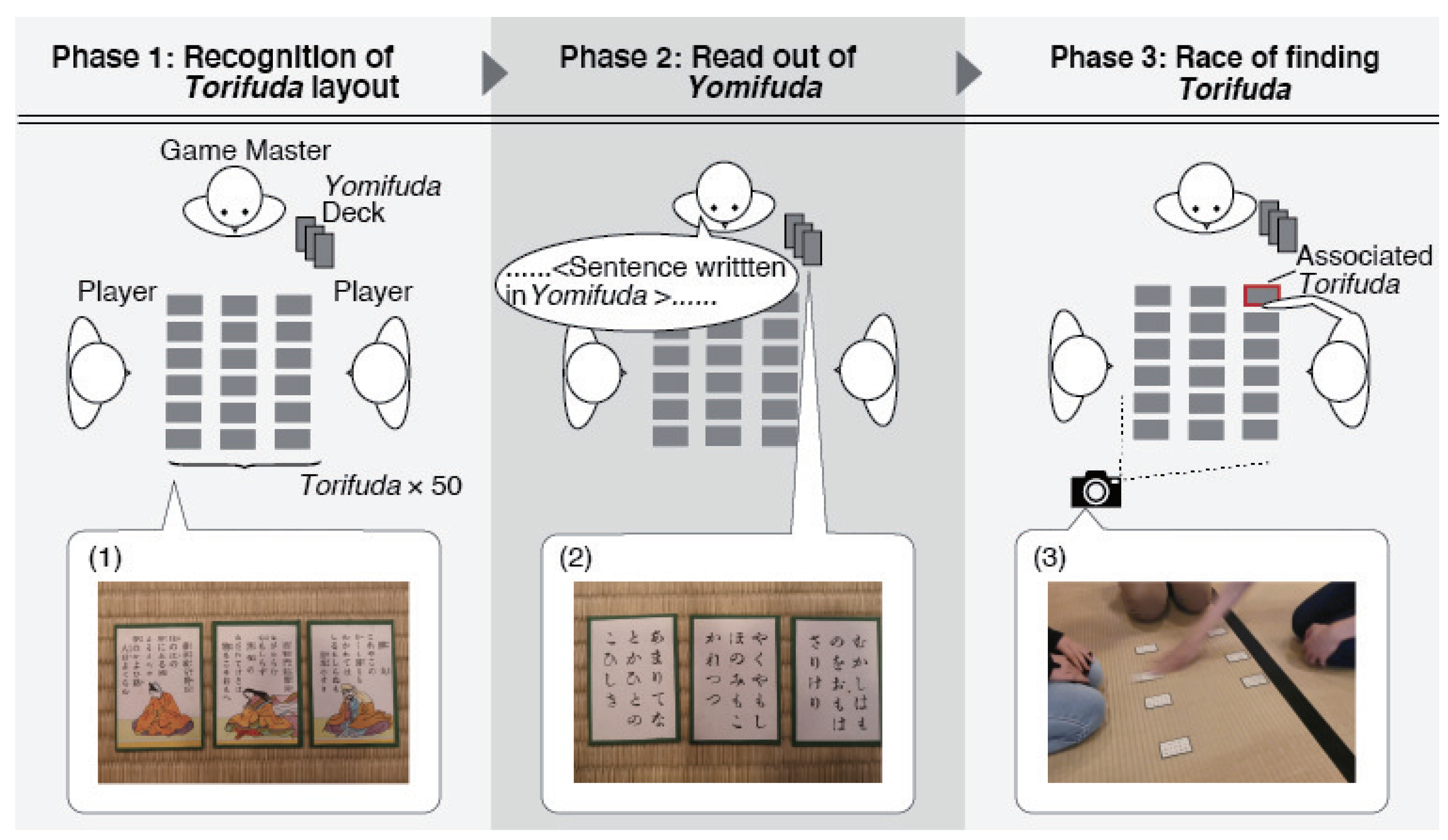
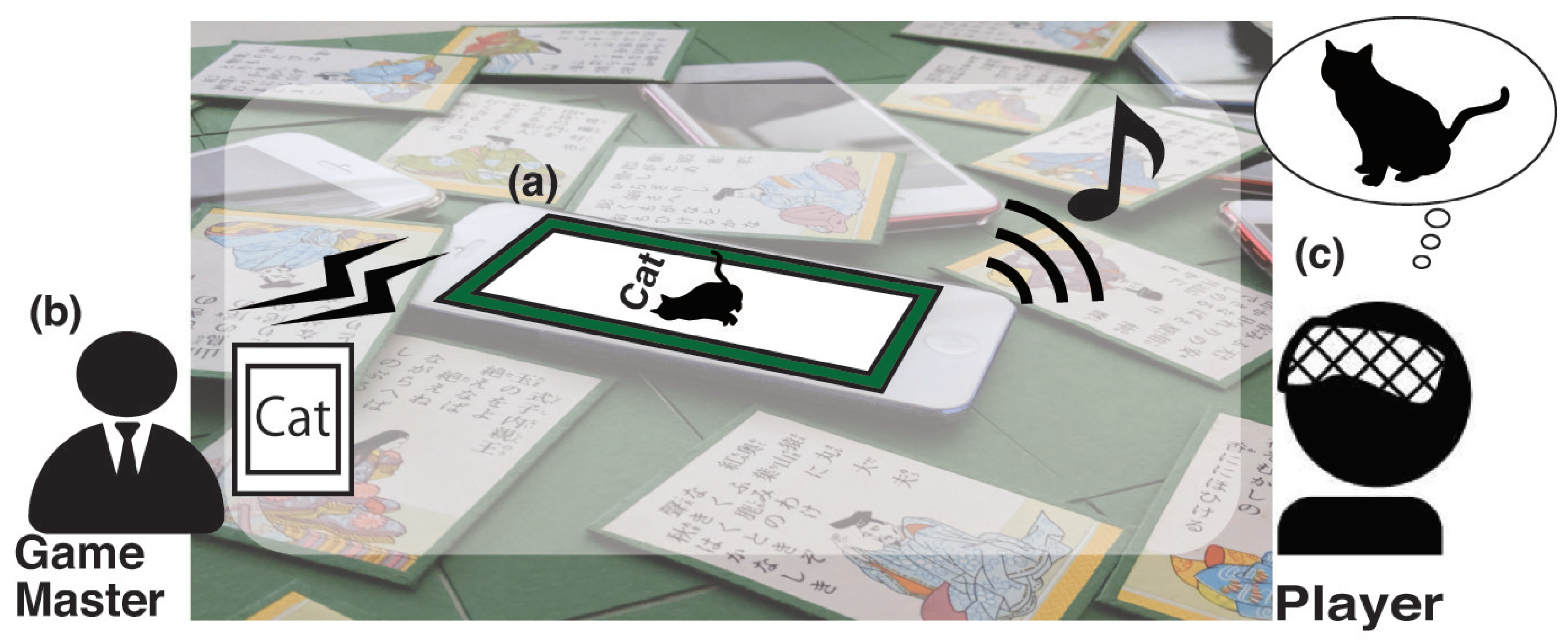
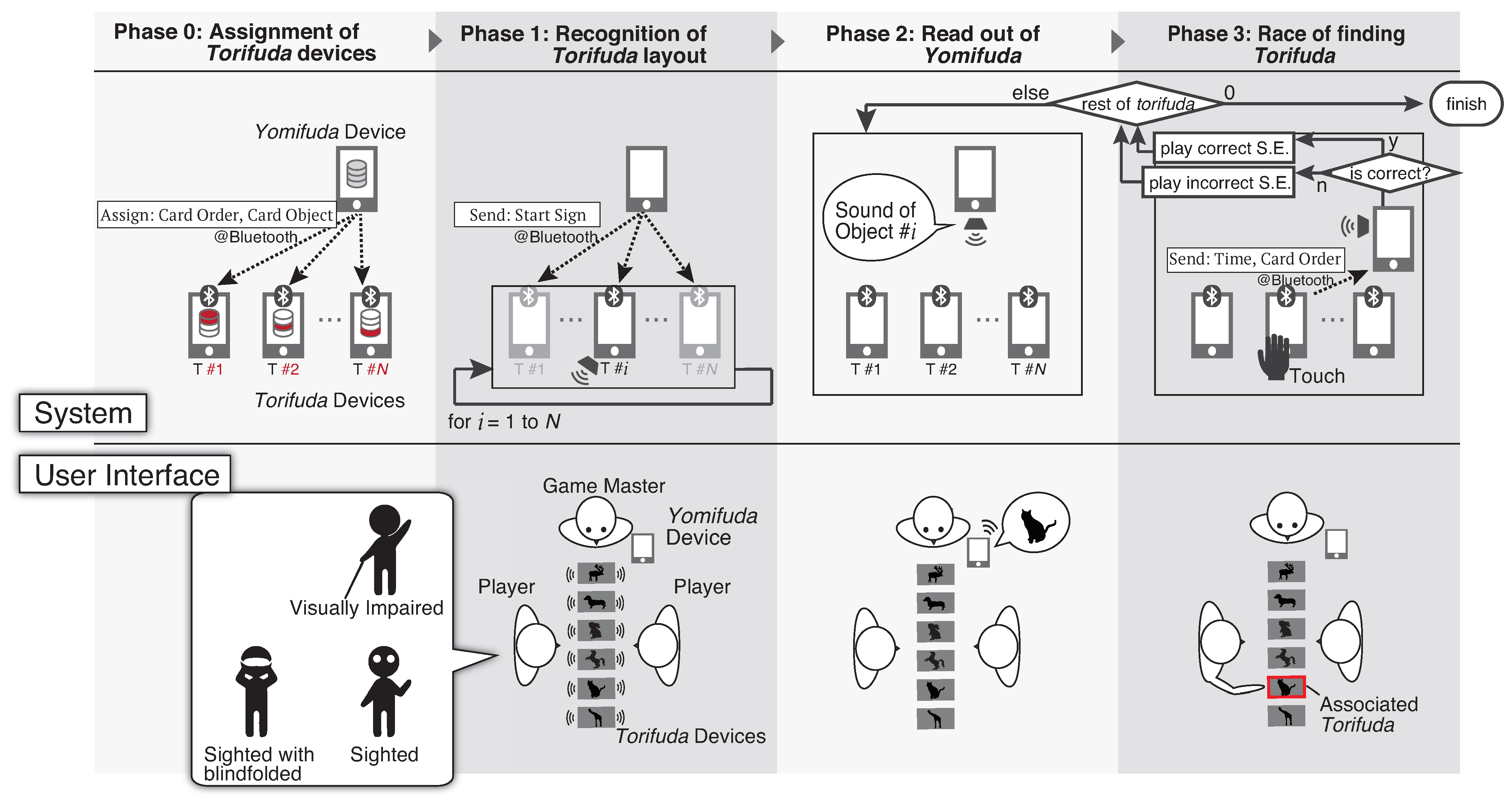
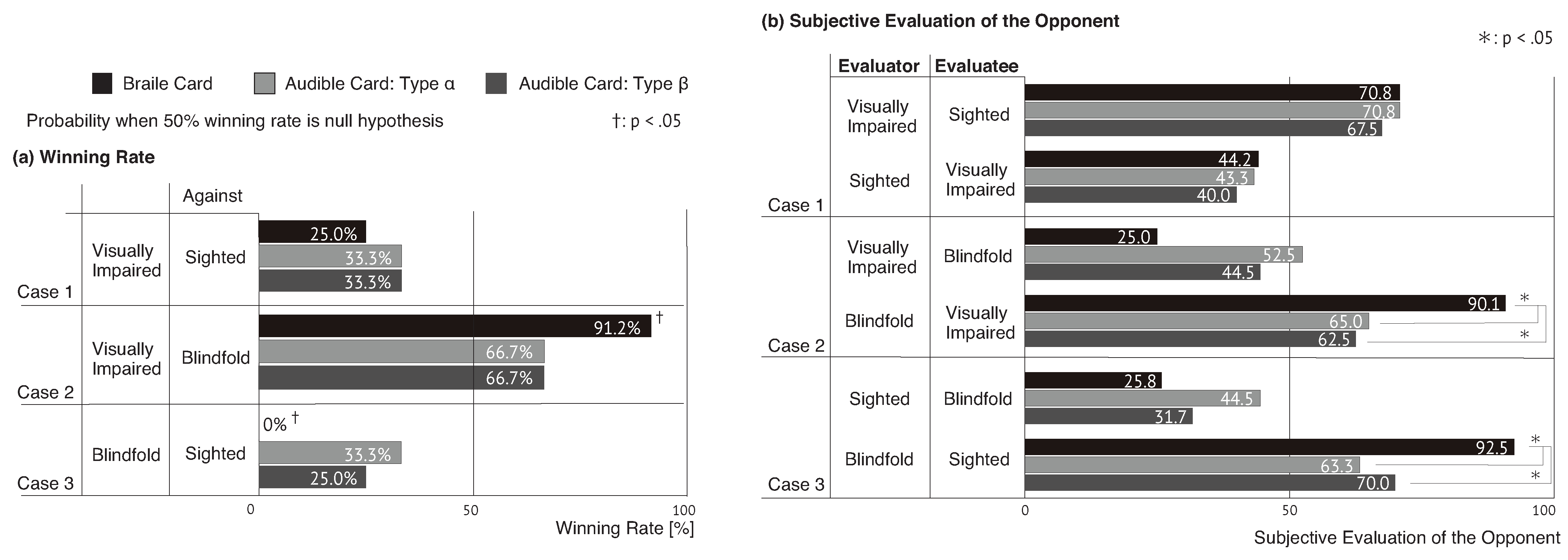
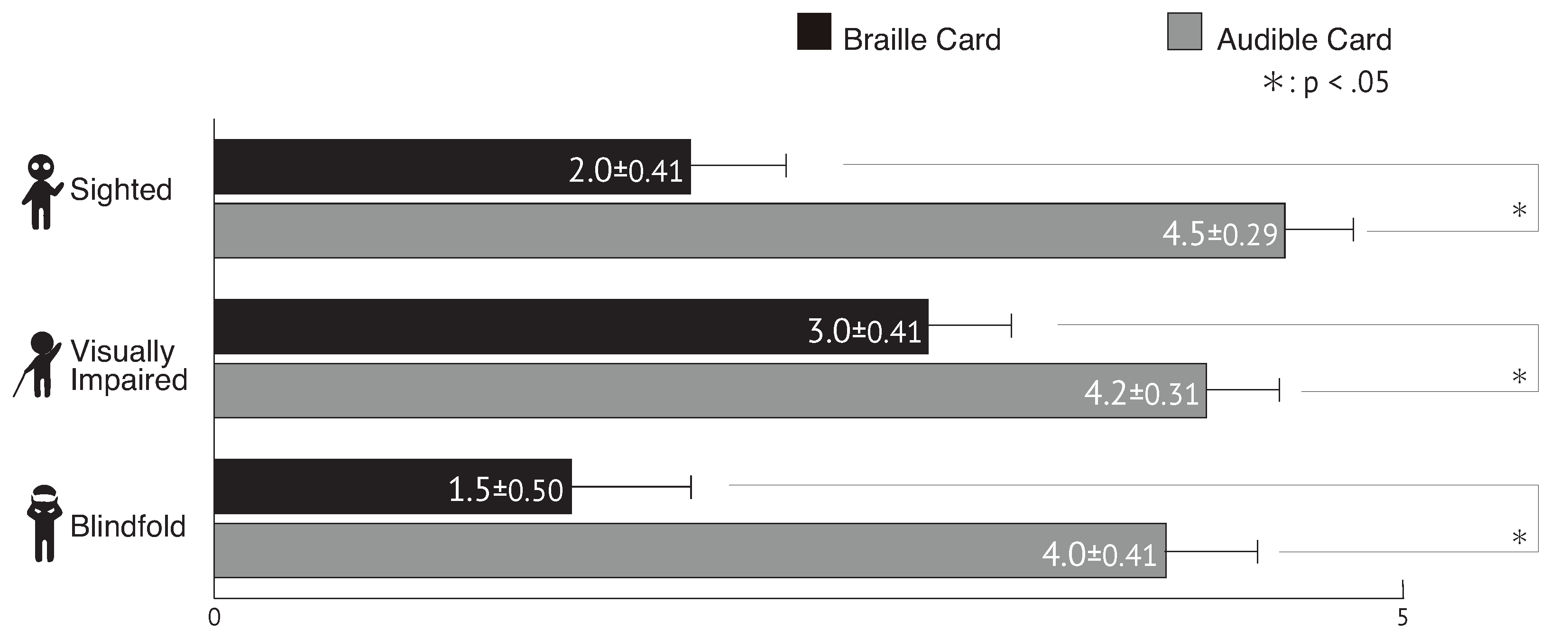
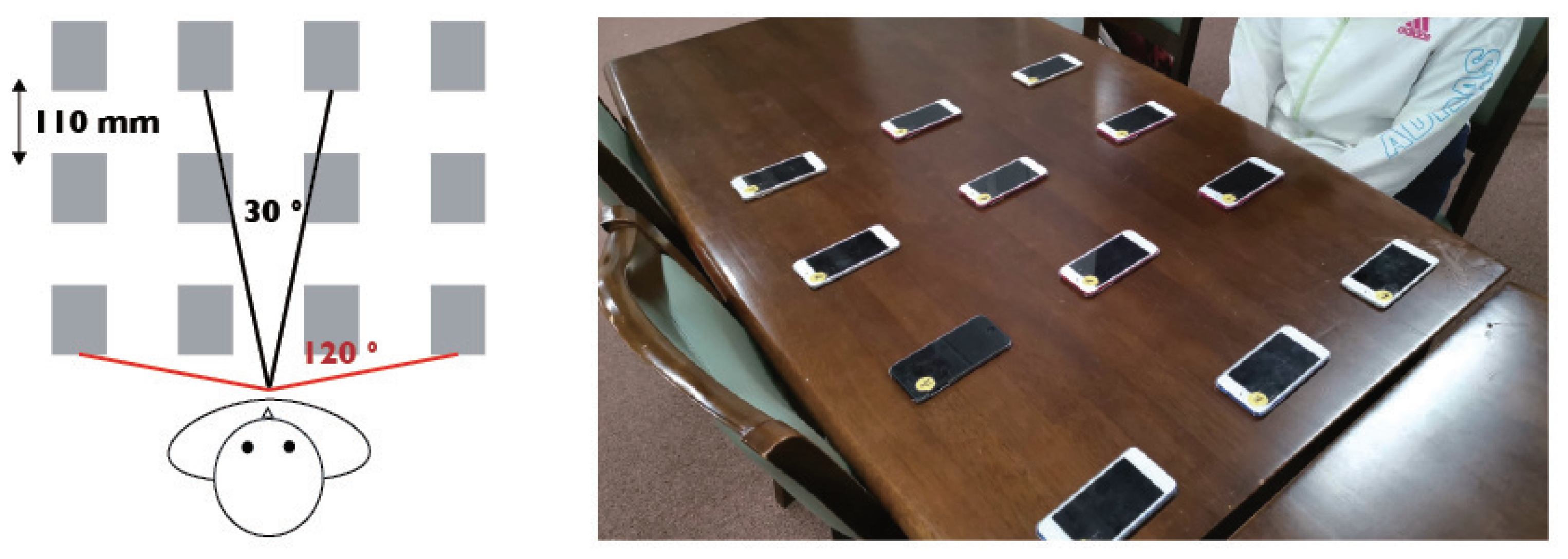
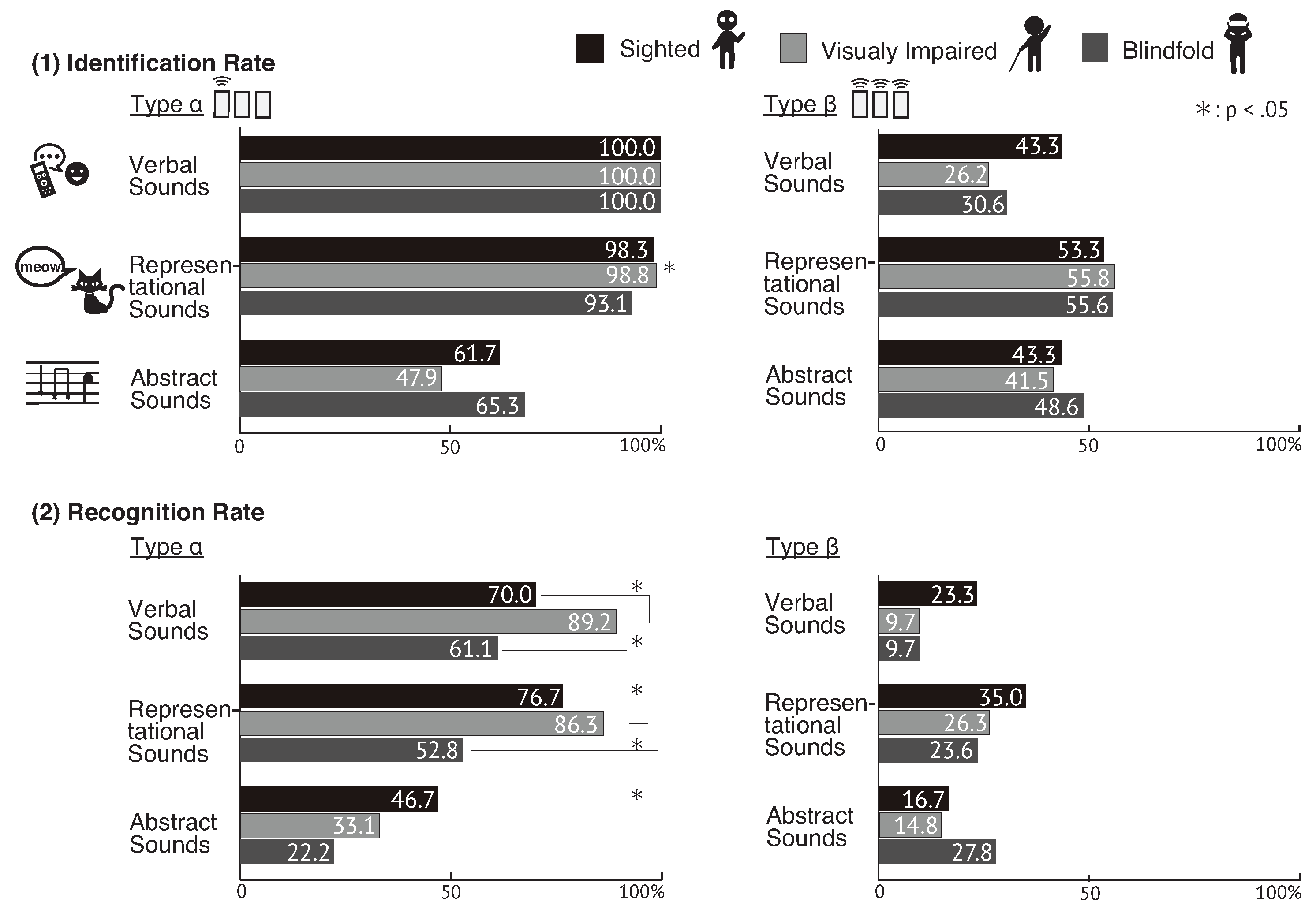
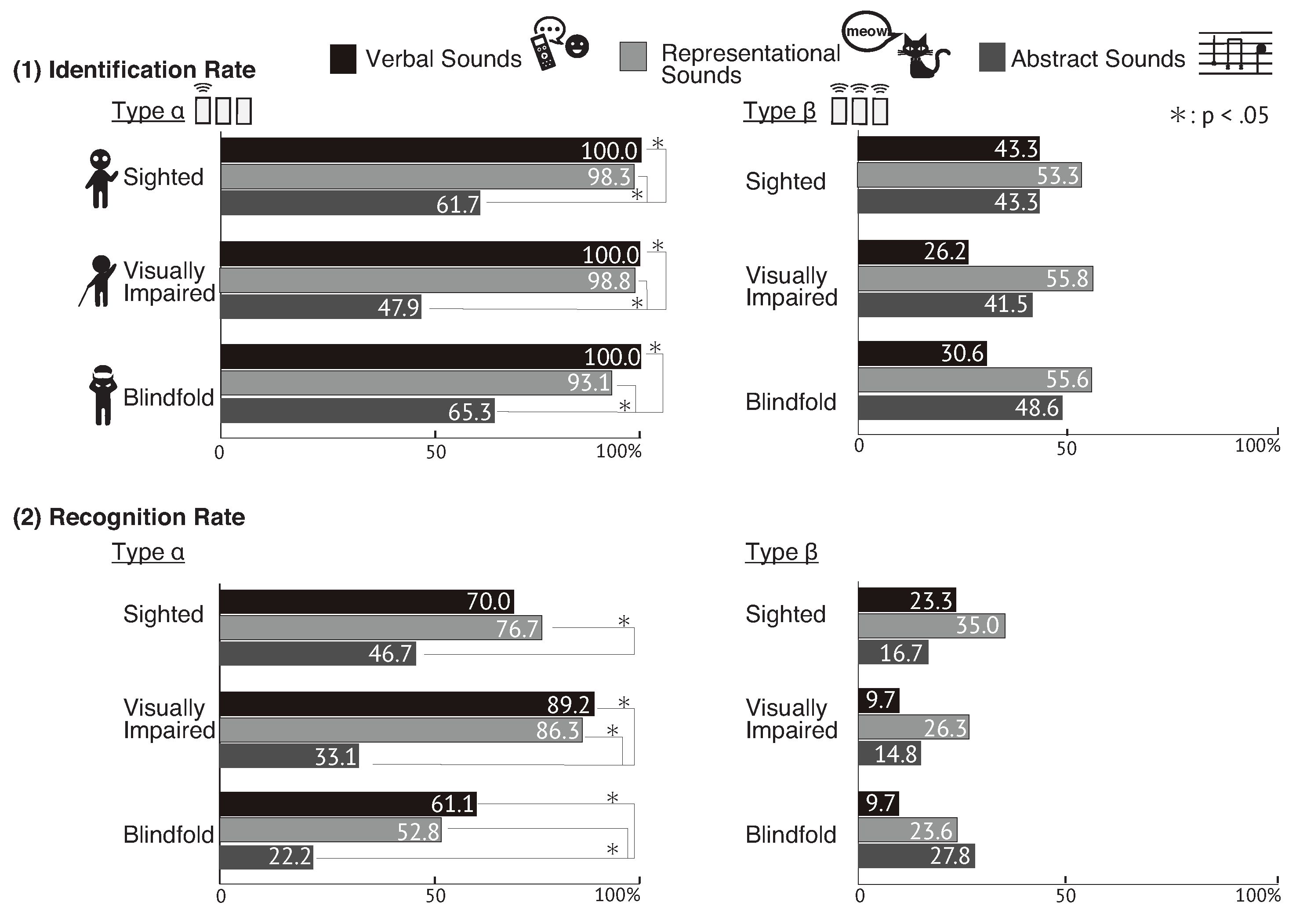
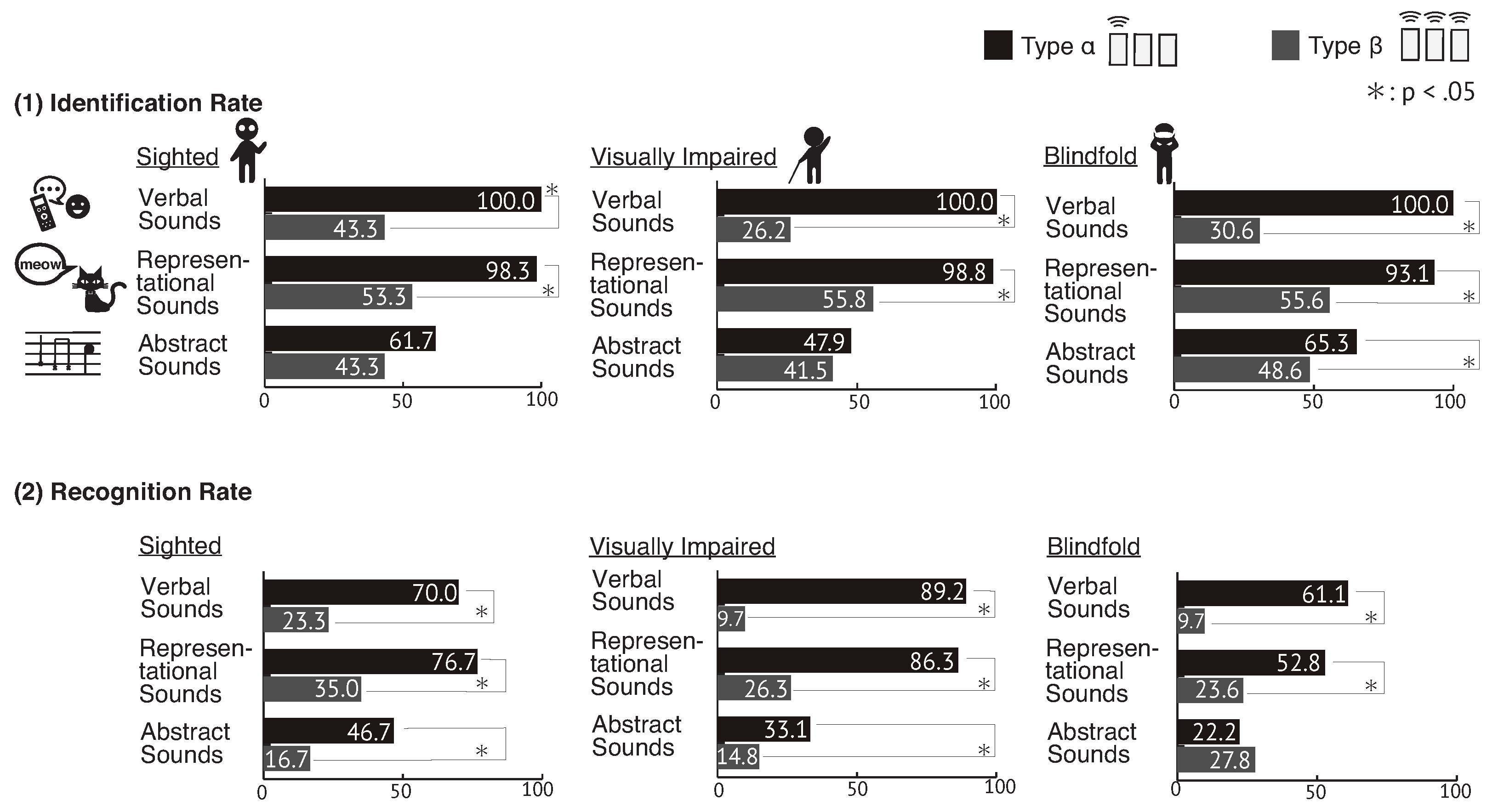
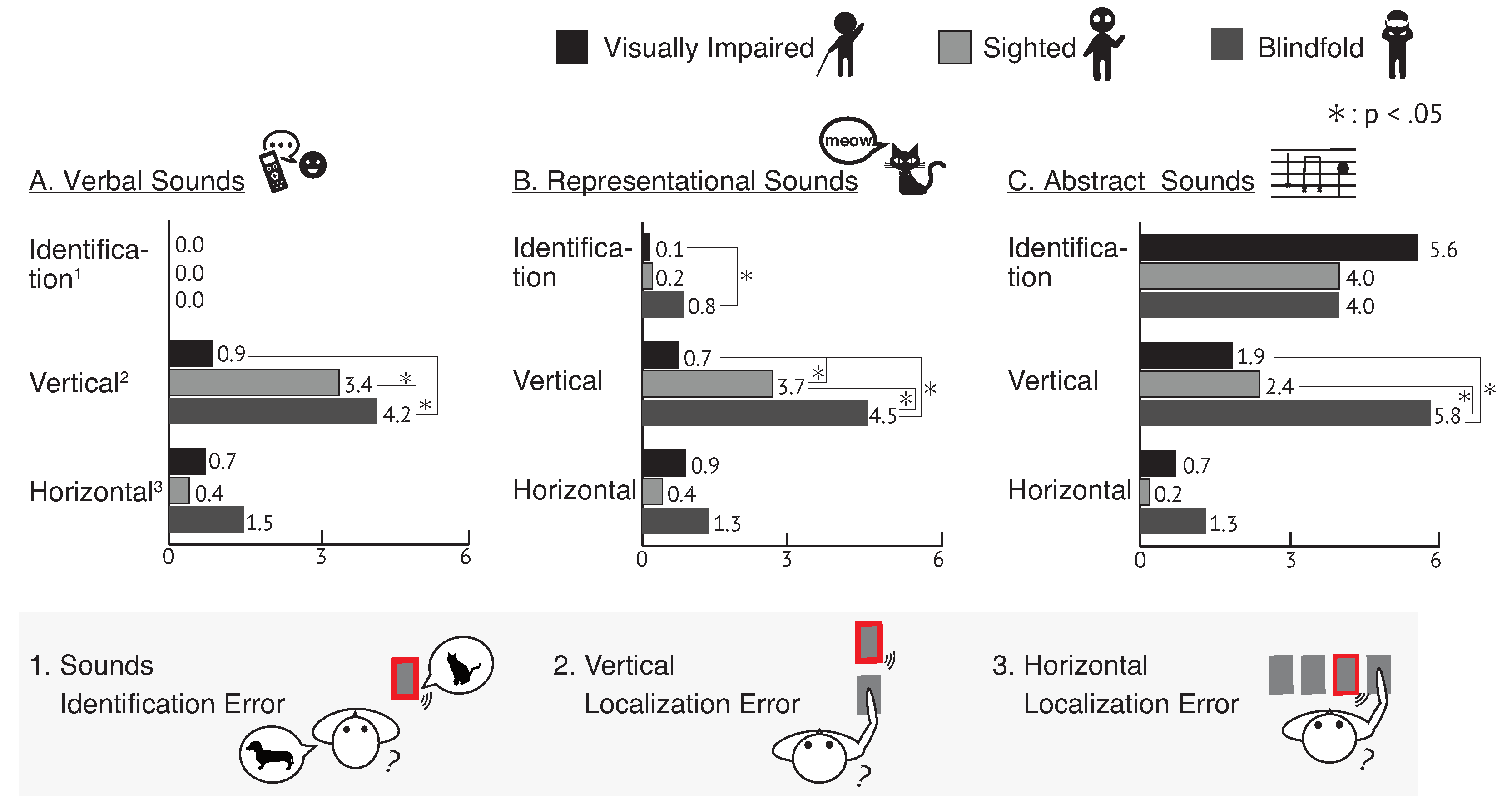
| UA-Chess [25] | Splendor [24] | Hanabi [13] | Uno [12] | Auditory Uta-Karuta [14] | |
|---|---|---|---|---|---|
| The Role of Component | Public | Public/Private | Private | Private | Public |
| Equipment | PC | Card with Texture | Bigger Card | Card with Texture | Small Tablet-type Device |
| Input | Mouse, Keyboard, Voice | Touch Components | Look at Components | Touch Components | Game Master Operations |
| Output | Audio Cue, Screen reader | Haptic Sensation | Visual Sensation | Haptic Sensation | Auditory Sensation |
| Modality | Audio | Haptic | Visual | Haptic | Audio |
| A: Verbal Sounds | Non-Verbal Sounds | ||
|---|---|---|---|
| Summary | Sound presentation using real world sounds | B: Representational Sounds | C: Abstract Sounds |
| Real world sounds that have a direct association with an object | Synthetic sounds with artificial correspondence without using real world sounds | ||
| Advantage | Provide clear information | Intuitive understanding by analogy | Systematic presentation |
| Disadvantage | Language limitations | Cannot represent all the events | Lack of meaningful relationship with their referent |
| Degree of Visual Impairment | Audio Types | The Style of Sound Playback |
|---|---|---|
| 1: Sighted | A: Verbal | Type : Play sounds one by one in order |
| 2: Visually impaired | B: Representational | Type : Play sounds simultaneously |
| 3: Sighted with blindfold | C: Abstract |
| Card Contents | Verbal Sound | Representational Sound |
|---|---|---|
| Cat | ne\ko | Cat’s meow |
| Glass | ɡ \ɾas | Pouring water into a glass |
| Cow | \ɕ | Cow’s bark |
| Toad | ka\eɾ | Frog’s croak |
| Knife | na\iɸ | Cutting food with a knife |
| Keyboard | kjiːbo\ːdo | Tapping a keyboard |
| Crow | kaɾas | Crow’s caw |
| Dog | in \ | Dog’s bark |
| Scissors | hasamji | Scissors cutting paper |
| Dentifrice | hab \ɾaɕi | Brushing one’s teeth. |
| Hair Dryer | do\ɾaija | Drying one’s hair with a hair dryer |
| Cicada | semji | Cicada noise |
Publisher’s Note: MDPI stays neutral with regard to jurisdictional claims in published maps and institutional affiliations. |
© 2021 by the authors. Licensee MDPI, Basel, Switzerland. This article is an open access article distributed under the terms and conditions of the Creative Commons Attribution (CC BY) license (http://creativecommons.org/licenses/by/4.0/).
Share and Cite
Miyakawa, H.; Kuratomo, N.; Salih, H.E.B.; Zempo, K. Auditory Uta-Karuta: Development and Evaluation of an Accessible Card Game System Using Audible Cards for the Visually Impaired. Electronics 2021, 10, 750. https://doi.org/10.3390/electronics10060750
Miyakawa H, Kuratomo N, Salih HEB, Zempo K. Auditory Uta-Karuta: Development and Evaluation of an Accessible Card Game System Using Audible Cards for the Visually Impaired. Electronics. 2021; 10(6):750. https://doi.org/10.3390/electronics10060750
Chicago/Turabian StyleMiyakawa, Haruna, Noko Kuratomo, Hisham E. Bilal Salih, and Keiichi Zempo. 2021. "Auditory Uta-Karuta: Development and Evaluation of an Accessible Card Game System Using Audible Cards for the Visually Impaired" Electronics 10, no. 6: 750. https://doi.org/10.3390/electronics10060750
APA StyleMiyakawa, H., Kuratomo, N., Salih, H. E. B., & Zempo, K. (2021). Auditory Uta-Karuta: Development and Evaluation of an Accessible Card Game System Using Audible Cards for the Visually Impaired. Electronics, 10(6), 750. https://doi.org/10.3390/electronics10060750







